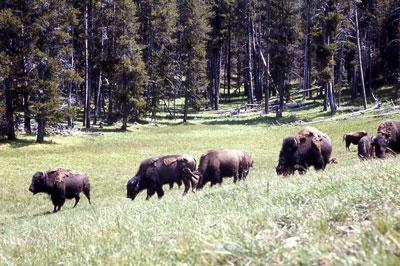The winter of 2010-2011 was considerably snowier than usual across much of the West, but how did that affect animals such as the bison in Yellowstone National Park?
Scientists have released the results from the park's annual summer bison population count, and it offers some answers.
According to the survey, the population this summer is estimated to be 3,700 bison. For purposes of comparison, the population was estimated at 3,900 bison last summer. The peak population estimate of 5,000 bison was recorded in the summer 2005.
There are an estimated 2,300 bison on the Northern Range this summer, with 1,400 in the Central Interior herd. The counts are based on a series of aerial surveys.
Winter mortality for the past year was estimated at 500 bison. There were 583 calves-of-the-year observed in a June aerial survey.
A park spokesperson notes, "The observed rate of population change this past year is within the natural range of expectation for wild bison. The rate at which wildlife populations increase in abundance is a reflection of the combined effects of reproduction and mortality, and is heavily influenced by age structure of the population, and environmental conditions encountered over the course of time."
"This population estimate is used to inform adaptive management strategies under the Interagency Bison Management Plan (IBMP). Specific management actions may be modified based on expected late winter population levels as corroborated by the summer population estimate."


 Support Essential Coverage of Essential Places
Support Essential Coverage of Essential Places







Comments
One number missing from this article that ultimately accounts for the lower numbers is that 211 (by Buffalo Field Campaign's count - and I witnessed dozens of the deaths and gut piles myself) bison were killed between Montana's and the hunts of the treaty tribes (mostly by Salish-Kootenai and Nez Perce but some also by the Umatilla - the Shoshone-Bannock also have treaty rights but did not hunt). There were also another approximately 20 killed for other reasons (mostly from vehicles - there's also no way of knowing how many bison were killed by vehicles in the park) and some for other reasons (poaching, shot by IBMP agents, died in captivity, a calf that was hazed to death). Another 53 were removed from the herd for an experimental sterilization study.
Another note of interest that is somewhat in conflict with the statement from NPS was that Al Nash, the park spokesperson, had said that bison winter mortality is 5-10%, with 10% being a bad year. If 500 died of 3900, that was really severe winterkill. However, despite what Nash had said, winterkill has proven that it can be in the 12-13% range in bad winters (as the devastating 2007-2008 year showed, with a high winterkill and a record slaughter).
Now, a number of 200 fewer would be nothing to worry about if there weren't so many concerns about the ultimate health of the herd. What's more, the number is only as high as it is because Gov. Schweitzer (though the strangest reasoning you'll ever see) stopped the slaughter this year. A minimum of 200 were slated for slaughter. This number was surely a bare minimum, as many hundreds more streamed out of the park after Schweitzer's February announcement. There also would have been no guarantee that seronegative bison would have been spared. Had the IBMP partners been able to carry out their slaughter, the numbers would have been down by much more (as many pregnant females also would have been shipped to slaughter).
Moreover, without the stroke of miraculous luck of the governor's executive order, it would have been the usual doubly bad situation where a bad winter produces a lot of winterkill and government kill just as in 2007-2008.
One thing one wonders, too, on winterkill totals, is whether more bison are in fact staying in the park over time because of the IBMP. I don't think there is much evidence to support it except that migration routes that previously existed (like to the Taylor Fork area northwest of the park) are no longer utilized despite bison populations in the park at or near historical highs. Migration routes do change, and research in the last year on migratory animals points to the loss of those routes when the genetic leaders are killed. If more bison stay in the park due only to the crazy politics of this situation, then to what extent is winterkill actually "natural" and only due to the winter.
So, the bison population is a little down; it probably isn't a cause for great concern simply on the basis of the numbers. That really is by an extremely lucky break back in February.
I experienced an entire season in the field with the buffalo. It was both amazing and heartbreaking. The reason I don't post here or anywhere else as much as I used to is that I'm in the middle of writing a book about it all (or still in the grueling pre-stages). The thing, I urge, though, is for readers to be careful when reading NPS press releases about bison and the spin they put on the information. Looked through a fully-informed lens, the situation is not nearly as normal as it is being portrayed.